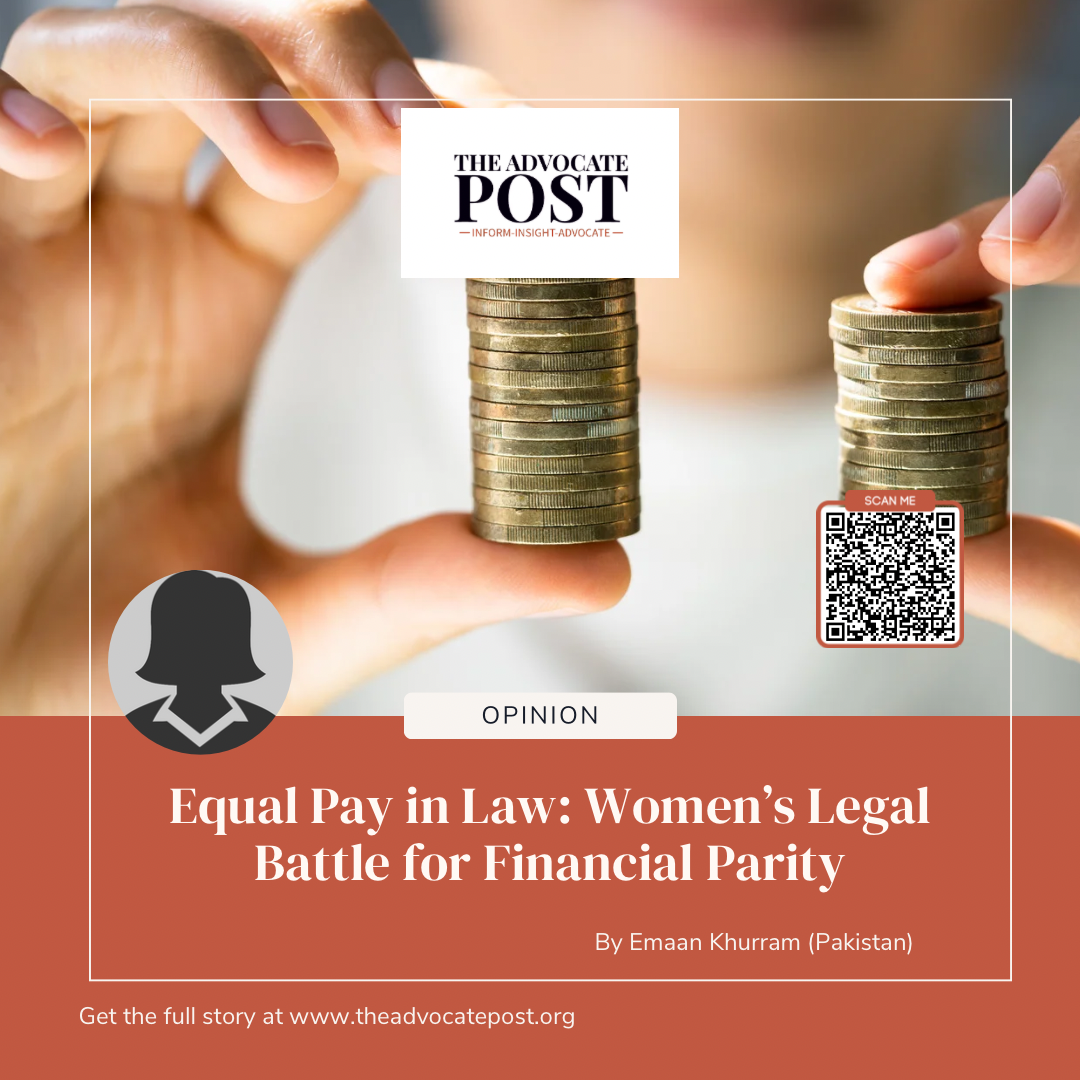By Emaan Khurram (Pakistan)
Despite decades of progress, the fight for equal pay in the legal profession remains one of the most persistent gender equality battles women face today.
For much of history, women were barred from entering the legal profession. Bebb v. The Law Society (1913), a landmark case, demonstrated these difficulties when Gwyneth Bebb was refused to practice law as a solicitor due to her gender alone. Despite the case’s failure, it set the stage for further advancement. Over time, women gained access to legal practice, but pay inequality became a significant hurdle. Women entered the industry in greater numbers than men, but they were usually paid less than men, especially in higher-paying fields like law, contributing to the pay gap that still exists today.
However, several significant legal frameworks have been developed to deal with wage inequalities. The Equal Pay Act of 1963 was a historic piece of legislation in the United States that attempted to end gender-based salary disparities. It mandates that in the same establishment, men and women must be paid equally for equivalent labour. Despite its intentions, enforcement remains a challenge, and many women still find themselves fighting for fair compensation. In the UK, the Equality Act 2010 serves a similar purpose, consolidating and strengthening prior legislation against discrimination. It prohibits discriminatory treatment based on gender and mandates equal compensation for equal labour.
In addition to legislation, several significant legal cases illustrate the ongoing struggle for pay equity. A female lawyer successfully sued for wage discrimination in McCrory v. Rapides Regional Medical Centre (2000), claiming that her male colleagues were paid more for comparable work. This case established an important precedent that supported women’s legal challenges to pay inequality in the legal profession.
More recently, the Australian case Smith v. Martin (2021) brought attention to current concerns about wage equity. In one instance, a female attorney claimed that the pay scale at her place of employment discriminated against her based on her gender, resulting in a lesser salary than that of her male colleagues. A rising awareness of gender-based pay inequities in the legal profession is reflected in the court’s decision in favour of the plaintiff, which highlighted the significance of accountability and transparency in pay practices.
Moreover, recent studies examining gender pay gaps in large law firms have highlighted significant disparities in compensation and advancement opportunities. For instance, a study of major firms such as Clifford Chance revealed that female associates often have fewer billable hours compared to their male counterparts, which directly affects their earnings. The problem is exacerbated by the underrepresentation of women in top leadership positions, which are usually associated with greater salaries and bonuses. Although women make up an important percentage of recent law graduates, the study discovered that their advancement to partnership levels is still slow. This widens the already-existing pay disparity and prompts questions about institutionalised discrimination in the legal profession’s compensation and promotion policies.
Although there has been progress in reducing the disparity in pay within the legal industry, there are still large obstacles to overcome. A number of legal firms have started implementing programs that support fair compensation practices, salary transparency, and employee understanding of pay structures. By putting in place mentorship programs targeted at pushing women into leadership positions, some businesses are actively trying to close the gender wage gap.
Despite these positive changes, progress has been slow and often met with resistance. Given the continued influence of societal expectations and biases on workplace dynamics, women who negotiate for promotions or better wages sometimes face criticism. Moreover, the persistent lack of female representation in high-level roles impedes their capacity to bring about significant transformations in companies.
Achieving gender pay equality in the legal profession is essential for creating a fair and just workplace. Despite significant advancements, such as increased transparency and support programs, the gender pay gap remains a pressing issue, as illustrated by the disparities revealed in studies like that of Clifford Chance. Moreover, law firms must prioritize not only equitable pay practices but also the advancement of women into leadership roles, ensuring a more inclusive and representative legal field. By addressing these challenges head-on, the profession can lead the way in promoting gender equality and integrity within its ranks.






This Post Has One Comment
Very well written! Highlights a significant issue which needs immediate redressal and a major overhaul of the system. Keep up the good work